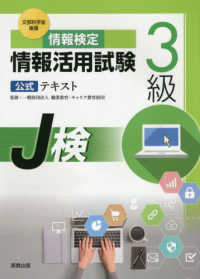Full Description
New research points to the future of education as online, student-centered, collaborative, and community-based—all largely absent from today's educational landscape. This guide teaches middle, high school, and college students how to reflect on what is right, good, and fair and then undertake research to address challenges in their curriculum and communities. The approach is deliberately designed to make it easy to bring ethical thinking and analytical problem-solving to the social studies and STEM curricula, as well as to experiential and inquiry-based learning such as project-based and service learning. Organized around the steps in the social science research method, each step can be linked to curriculum and national standards and taught individually as stand-alone lessons or sequentially as part of a semester or yearlong research seminar. The text includes sample lesson plans, assignments, research questions, research tools, and research reports, as well as examples of concrete policy implementation and the kinds of evidence that can be used to assess and evaluate student work.Book Features:
Combines research and citizenship so students can bring knowledge to bear on the most important challenges facing them.
Designed for use with diverse students in inclusive classrooms.
Developed in a university setting and field tested for over a decade in high schools.
Connects K-12 to college and career in an organic and substantive manner.
Works with and compliments curriculum that teachers are already using.
Contents
Preface
Acknowledgments
Introduction
What Is Tools for Change?
What Is the TfC Guide?
How to Use the TfC Guide
Research = Inquiring with Intention
Assessment Overview
TfC Research Steps:
Step 1. Perspective: Developing Engaged Perspectives
Step 2. Question: Identifying and Framing Empirical Research Questions
Step 3. Conversation: "Conversing" with other Researchers and Writing a Literature Review
Step 4. Design: Developing a Plan to Collect Data to Answer a Research Question
Step 5. Data: Researching with Integrity: Ethical Data Collection
Step 6. Analysis: Analyzing Data to Answer a Research Question
Step 7. Implementation: Putting New Knowledge to Use
Postscript
Appendix A: Student Self-assessment Rubric Elements
Appendix B: Seeing and Being Rubric
Appendix C: Student Team Leadership Rubric
Notes
Index
About the Authors







